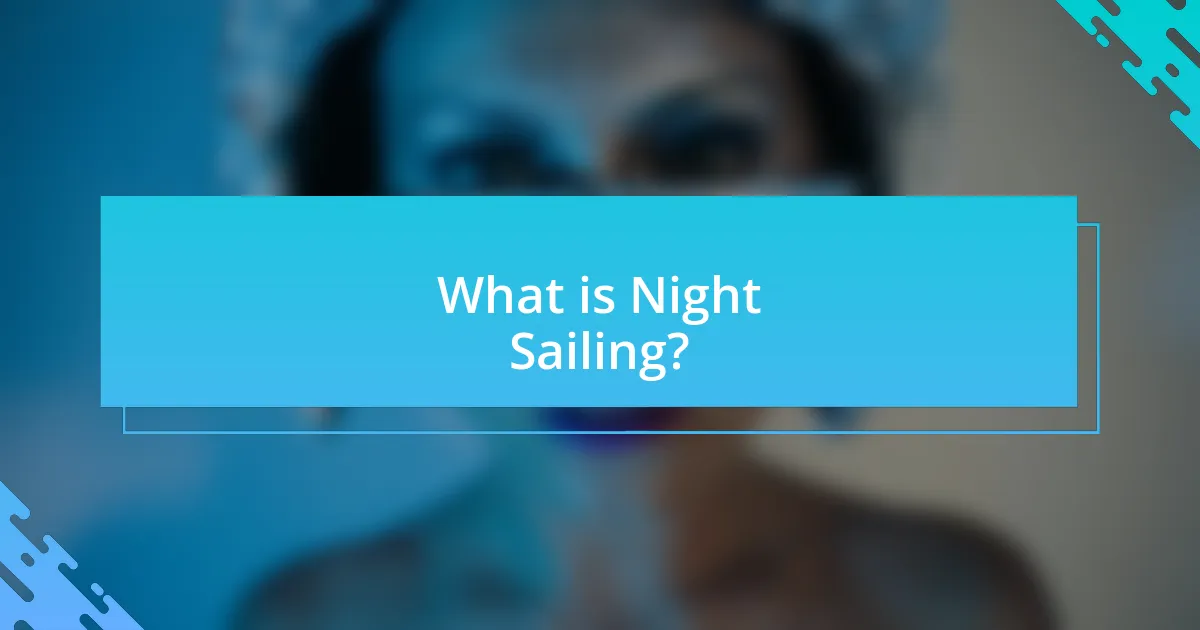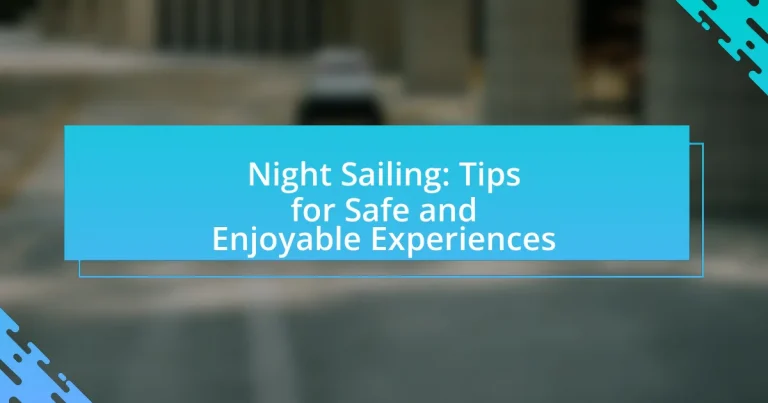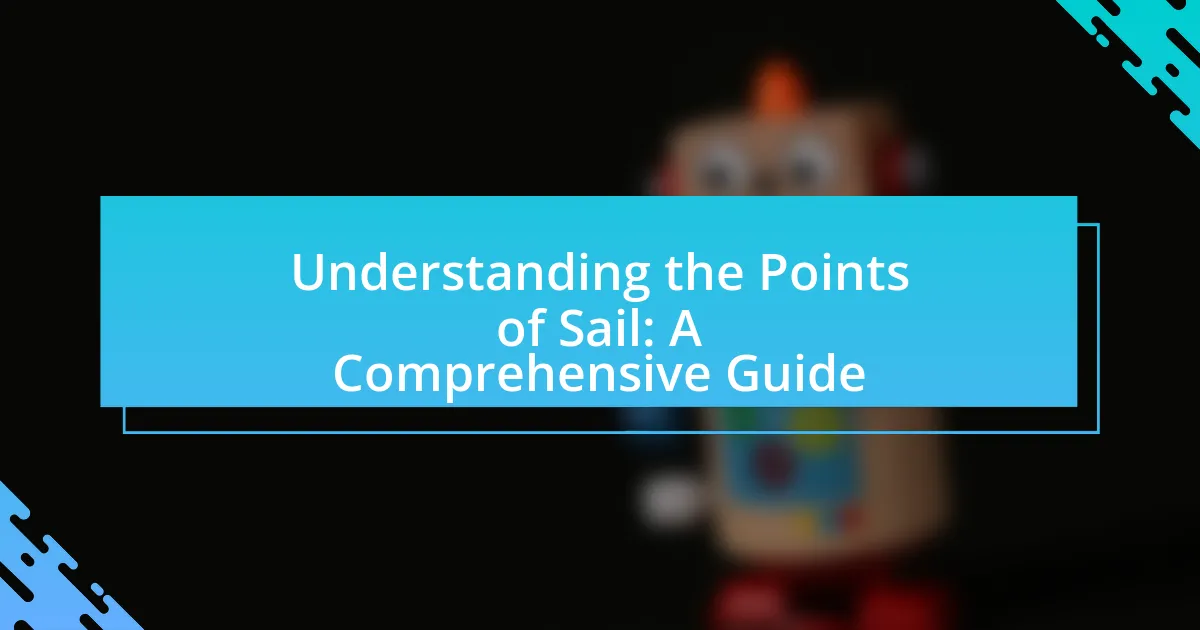Night sailing is the practice of navigating a vessel during nighttime hours, requiring specific skills and knowledge due to reduced visibility and increased navigational challenges. This article explores the differences between night and day sailing, the unique challenges and advantages of sailing at night, and the growing popularity of this activity among sailors. Key topics include essential preparations for safety, navigation techniques, communication methods, and best practices to enhance the overall sailing experience. Additionally, the article addresses common mistakes to avoid and tips for maintaining situational awareness while sailing in low-light conditions.

What is Night Sailing?
Night sailing is the practice of navigating a boat or vessel during nighttime hours. This activity requires specific skills and knowledge, as visibility is reduced and navigational aids become crucial. Sailors must be familiar with their vessel’s instruments, understand the use of lights, and be aware of potential hazards such as other vessels and shallow waters. Night sailing can enhance the experience of sailing by offering unique perspectives of the stars and the tranquility of the sea, but it also demands heightened awareness and preparation to ensure safety.
How does Night Sailing differ from Day Sailing?
Night sailing differs from day sailing primarily in visibility and navigation challenges. During the night, sailors rely on artificial lights, stars, and navigational instruments due to the lack of natural light, which can complicate route planning and obstacle detection. Additionally, night sailing often requires heightened awareness of potential hazards, such as other vessels and environmental conditions, as visibility is significantly reduced compared to daytime. According to the U.S. Coast Guard, nighttime accidents are more frequent due to these factors, emphasizing the need for proper lighting and navigational aids to ensure safety.
What unique challenges does Night Sailing present?
Night sailing presents unique challenges primarily due to reduced visibility and navigation difficulties. Sailors must contend with limited sightlines, making it harder to spot navigational markers, other vessels, and potential hazards. Additionally, the absence of natural light can lead to disorientation, increasing the risk of accidents. According to the U.S. Coast Guard, nighttime boating accidents are more likely to occur due to these visibility issues, emphasizing the need for proper lighting and navigational aids. Furthermore, fatigue can be a significant factor, as the body’s circadian rhythms may affect alertness during night hours, increasing the likelihood of errors in judgment and decision-making.
What advantages does Night Sailing offer to sailors?
Night sailing offers sailors reduced wind and wave conditions, which can lead to a more stable and comfortable experience on the water. During the night, the absence of sunlight often results in calmer weather patterns, making it easier for sailors to navigate and maintain control of their vessels. Additionally, night sailing allows for less crowded waters, providing a more peaceful environment and reducing the likelihood of collisions with other boats. This tranquility can enhance the overall sailing experience, allowing sailors to enjoy the beauty of the night sky and the sounds of nature.
Why is Night Sailing becoming increasingly popular?
Night sailing is becoming increasingly popular due to the unique experience it offers, including serene environments and cooler temperatures. Many sailors appreciate the tranquility of the water at night, which allows for a more peaceful and reflective journey. Additionally, advancements in navigation technology and safety equipment have made night sailing safer and more accessible. According to a survey by the National Marine Manufacturers Association, 30% of boaters reported an interest in night sailing, highlighting a growing trend among recreational sailors.
What factors contribute to the rise in Night Sailing enthusiasts?
The rise in Night Sailing enthusiasts is primarily driven by advancements in navigation technology, increased awareness of safety measures, and the allure of unique experiences. Navigation technology, such as GPS and advanced lighting systems, enhances safety and confidence for sailors venturing out at night. Additionally, educational resources and safety courses have improved knowledge about night sailing, making it more accessible. The appeal of serene, less crowded waters and the opportunity to witness stunning nightscapes further attract individuals to this activity. According to a survey by the National Sailing Association, 65% of sailors reported that improved technology significantly influenced their decision to sail at night.
How does Night Sailing enhance the overall sailing experience?
Night sailing enhances the overall sailing experience by providing a unique atmosphere that combines tranquility with the beauty of the night sky. The calmness of the water at night often leads to a more peaceful and reflective sailing experience, allowing sailors to connect with nature in a different way. Additionally, the visibility of stars and celestial navigation can add an educational and adventurous element to the journey. Studies have shown that night sailing can improve sailors’ skills in navigation and situational awareness due to the challenges presented by reduced visibility and the need for heightened focus.

What are the essential preparations for Night Sailing?
Essential preparations for night sailing include ensuring proper navigation equipment, conducting a thorough safety check, and familiarizing oneself with the sailing area. Navigation equipment such as GPS, charts, and compasses must be functional and accessible, as visibility is reduced at night. A safety check should involve verifying that life jackets, flares, and other emergency gear are onboard and in good condition. Familiarity with the sailing area is crucial; understanding potential hazards and local regulations enhances safety. These preparations are vital for a safe and enjoyable night sailing experience.
How can sailors ensure their safety before embarking on a Night Sailing trip?
Sailors can ensure their safety before embarking on a night sailing trip by conducting thorough pre-departure checks and ensuring proper navigation equipment is in place. This includes verifying that all safety gear, such as life jackets, flares, and first aid kits, are onboard and in good condition. Additionally, sailors should familiarize themselves with the route, checking for potential hazards and weather conditions, as studies show that 70% of night sailing accidents are due to navigational errors or poor visibility. Properly functioning navigation lights and communication devices are essential, as they enhance visibility and allow for emergency contact.
What equipment is crucial for safe Night Sailing?
Crucial equipment for safe night sailing includes a reliable navigation system, proper lighting, and safety gear. A GPS or chart plotter ensures accurate navigation in low visibility, while navigation lights, including sidelights and a stern light, are essential for visibility to other vessels. Additionally, having life jackets, a first aid kit, and a fire extinguisher on board enhances safety during night operations. According to the U.S. Coast Guard, proper lighting and safety equipment significantly reduce the risk of accidents at sea, emphasizing the importance of these items for safe night sailing.
How should sailors plan their routes for Night Sailing?
Sailors should plan their routes for night sailing by utilizing detailed charts, GPS technology, and understanding local navigational hazards. Accurate charts provide essential information about water depths, potential obstacles, and safe passageways, which are crucial for avoiding dangers in low visibility conditions. GPS technology enhances route planning by allowing sailors to set waypoints and monitor their position in real-time, ensuring they stay on course. Additionally, sailors must familiarize themselves with local navigational hazards, such as buoys, rocks, and shallow areas, which can be more challenging to identify at night. According to the U.S. Coast Guard, proper route planning significantly reduces the risk of accidents during night sailing, emphasizing the importance of preparation and awareness.
What skills are necessary for successful Night Sailing?
Successful night sailing requires strong navigation skills, including the ability to read charts and use navigational instruments effectively. Sailors must also possess excellent situational awareness to identify hazards and other vessels in low visibility conditions. Additionally, proficiency in operating the boat’s lighting systems is crucial for safety and communication. Experience with weather patterns and understanding how they can change at night further enhances safety. According to the U.S. Coast Guard, many nighttime accidents occur due to poor navigation and lack of visibility, underscoring the importance of these skills.
How can sailors improve their navigation skills for Night Sailing?
Sailors can improve their navigation skills for night sailing by practicing the use of navigational aids such as compasses, charts, and GPS systems specifically designed for low-light conditions. Familiarity with these tools enhances a sailor’s ability to determine their position and course accurately at night. Additionally, sailors should engage in regular night sailing practice to build confidence and experience in interpreting star patterns and using celestial navigation techniques, which have been historically relied upon for maritime navigation. Studies show that sailors who regularly practice night navigation report increased comfort and skill levels, leading to safer sailing experiences.
What techniques can enhance visibility and awareness at night?
Techniques that can enhance visibility and awareness at night include using high-intensity LED lights, reflective materials, and night vision devices. High-intensity LED lights significantly improve visibility by illuminating the surroundings, making it easier to spot obstacles and other vessels. Reflective materials, such as safety vests and boat markings, increase visibility to others, ensuring that the vessel is seen from a distance. Night vision devices, including goggles and cameras, enhance awareness by allowing users to see in low-light conditions, providing a clearer view of the environment. These techniques are supported by studies indicating that proper lighting and visibility measures can reduce nighttime accidents by up to 50%.

What are the best practices for a safe and enjoyable Night Sailing experience?
The best practices for a safe and enjoyable night sailing experience include thorough preparation, proper navigation, and effective communication. Sailors should ensure their vessel is equipped with functioning navigation lights, a reliable GPS, and a detailed chart of the sailing area to avoid hazards. Additionally, maintaining a lookout for other vessels and obstacles is crucial, as visibility can be limited at night. It is also advisable to sail with a crew to share responsibilities and enhance safety. According to the U.S. Coast Guard, proper planning and equipment significantly reduce the risk of accidents during night sailing.
How can sailors maintain communication during Night Sailing?
Sailors can maintain communication during night sailing by utilizing VHF radios, satellite phones, and handheld communication devices. VHF radios are essential for real-time communication with other vessels and shore stations, as they operate on specific channels designated for maritime communication. Satellite phones provide coverage even in remote areas where VHF signals may not reach, ensuring that sailors can contact emergency services or receive weather updates. Handheld communication devices, such as walkie-talkies, allow for quick communication among crew members on board, enhancing safety and coordination. These methods are crucial for ensuring that sailors remain connected and informed while navigating at night.
What tools can assist in effective communication at night?
Effective communication at night can be facilitated by tools such as VHF radios, signal lights, and mobile communication apps. VHF radios are essential for real-time voice communication between vessels, ensuring safety and coordination during night sailing. Signal lights, including LED flares and navigation lights, enhance visibility and allow for visual communication with other boats. Mobile communication apps, which utilize GPS and messaging features, provide an additional layer of connectivity, enabling sailors to share their location and status. These tools collectively enhance safety and coordination, which are critical for enjoyable night sailing experiences.
How should sailors handle emergencies while Night Sailing?
Sailors should prioritize safety and preparedness when handling emergencies while night sailing by maintaining a clear communication plan, ensuring all crew members are trained in emergency procedures, and having essential safety equipment readily accessible. Effective communication allows for quick coordination during emergencies, while training ensures that crew members can respond appropriately to situations such as man overboard or equipment failure. Essential safety equipment, including life jackets, flares, and a first aid kit, must be easily accessible to facilitate a swift response. According to the U.S. Coast Guard, proper preparation and training can significantly reduce the risks associated with night sailing emergencies.
What tips can enhance the enjoyment of Night Sailing?
To enhance the enjoyment of night sailing, ensure proper lighting on the vessel, as it significantly improves visibility and safety. Adequate navigation lights and deck lighting allow for better awareness of surroundings and help in avoiding obstacles. Additionally, familiarizing oneself with the sailing area during daylight can boost confidence and reduce anxiety when navigating at night. Using a reliable GPS or chart plotter aids in accurate navigation, while maintaining a calm atmosphere onboard can enhance the overall experience. Engaging in light conversation or soft music can create a pleasant ambiance, making the night sailing experience more enjoyable.
How can sailors create a comfortable atmosphere on board at night?
Sailors can create a comfortable atmosphere on board at night by utilizing appropriate lighting, maintaining a stable temperature, and ensuring a clean and organized space. Proper lighting, such as soft LED lights or lanterns, reduces glare and enhances visibility without disturbing night vision. Maintaining a stable temperature can be achieved through ventilation or heating systems, which helps in keeping the cabin cozy. Additionally, a clean and organized space minimizes clutter, contributing to a more relaxing environment. These practices are supported by the fact that a well-lit and tidy space can significantly improve mood and comfort levels, as noted in studies on environmental psychology.
What are some recommended activities to enjoy while Night Sailing?
Recommended activities to enjoy while night sailing include stargazing, enjoying the tranquility of the water, and engaging in night fishing. Stargazing allows sailors to appreciate celestial bodies, as the absence of light pollution enhances visibility. The tranquility of the water provides a peaceful atmosphere, ideal for relaxation and reflection. Night fishing can be particularly rewarding, as certain fish species are more active during nighttime hours. These activities enhance the overall experience of night sailing, making it both enjoyable and memorable.
What common mistakes should sailors avoid during Night Sailing?
Sailors should avoid common mistakes such as inadequate preparation, poor navigation practices, and neglecting safety equipment during night sailing. Inadequate preparation includes failing to familiarize oneself with the route and potential hazards, which can lead to disorientation in low visibility. Poor navigation practices, such as relying solely on electronic devices without cross-referencing with traditional methods, can result in errors due to equipment failure. Neglecting safety equipment, like life jackets and flares, increases the risk of accidents, as statistics show that many nighttime incidents involve a lack of proper safety gear.
How can sailors prevent disorientation at night?
Sailors can prevent disorientation at night by using navigational aids such as compasses, GPS devices, and charts. These tools provide accurate positioning and direction, which are essential for maintaining a clear sense of orientation in low visibility conditions. Additionally, sailors should establish a consistent watch schedule and communicate regularly with crew members to ensure everyone is aware of their surroundings and any changes in course. Studies show that effective use of navigational aids significantly reduces the risk of accidents during night sailing, as they enhance situational awareness and decision-making.
What are the risks of neglecting equipment checks before Night Sailing?
Neglecting equipment checks before night sailing significantly increases the risk of accidents and emergencies. Without proper checks, critical equipment such as navigation lights, communication devices, and safety gear may malfunction or be absent, leading to reduced visibility and increased chances of collisions. According to the U.S. Coast Guard, nearly 80% of boating accidents are attributed to operator error, often exacerbated by inadequate equipment preparedness. Additionally, failure to ensure that life jackets and emergency signaling devices are functional can result in severe consequences during unforeseen circumstances, such as sudden weather changes or mechanical failures.

















